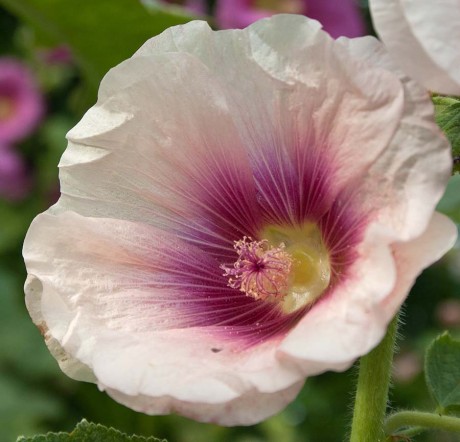Your grandmother’s hollyhocks
Plus Garden To-Do's for August and September
By L.A. JacksonIf your grandmother was a constant gardener, chances are pretty good she grew hollyhocks (Alcea rosea). An old-fashioned favorite, hollyhocks can be striking, colorful additions to any landscape.
So, why aren’t they seen in more gardens these days?
It’s probably because a lot of pests and diseases love hollyhocks. Leaf miners, weevils, Japanese beetles, spider mites, sawflies, slugs and other pests stand in line for a chance at these plants, while rust and powdery mildew are constant threats.
And then there is the fact that many hollyhocks are biennial, a weird plant-growing state that not all gardeners understand. A biennial is simply a plant that is started from seed one year and matures the next year.
So why bother growing hollyhocks at all? Well, because they are so darn pretty, and since their spikes of single or double blooms can stretch over 6 feet tall, they can make quite a statement in the landscape. Many bad bugs can be held in check by periodic applications of insecticidal soap sprays or pyrethrins-based pesticides, while rust-resistant varieties and fungicides are available. And if the hollyhocks do become completely overwhelmed with problems, it is usually after their cheerful flower show is on the wane in the summer, so the cure is to simply pull up the plants and toss them away.
Being biennial, hollyhocks are best seeded in our region in the late summer, meaning August is a prime planting time. Plant seeds in a sunny location in soil that is well-worked and heavily amended with organic material. If the planting site is open and exposed to prevailing winds, consider adding stakes now to support the tall hollyhocks-to-be later, or choose cultivars that grow 4 feet or less in height.
Since light helps germination, the seeds only need to be pressed into the soil surface. Spacing should be about 14 to 18 inches apart. Small rosettes will soon form and overwinter in the garden.
Come spring, hollyhocks will rapidly mature, and their growth should be encouraged by applications of diluted liquid fertilizer every two to three weeks. The beautiful flower spikes will soon begin their glorious show, and when these blooms are at their best, you’ll know why Granny always saved room for hollyhocks in her garden.
Garden To Do’s
August
- Even while the harvesting of summer veggies continues, later this month begin planting such cool-season favorites as lettuce, kale, turnips, radishes and spinach.
- Rake around fruit trees to remove fallen leaves and dropped fruit. This will help break up the life cycles of destructive insects and disease-producing organisms that might overwinter in the leftover plant material.
- Plant ornamental bulbs now? Sure — not spring-flowering bulbs but rather fall — blooming beauties such as colchicum, sternbergia and autumn-flowering crocus that will put on a show late in the growing season.
- If you have a fish aquarium, you also have an all-natural source of rich fertilizer, so whenever you change part of the water in the tank, pour it around some of your favorite plants.
September
- Fresh grass clippings and fall leaves are a great one-two combination of ingredients for creating a compost pile.
- Before the first frosts cut them down to the ground, mark the locations of herbaceous perennials so they won’t be accidentally dug up during next spring’s planting frenzy.
- Strange, cobweb-like tents beginning to show up in your trees? No, they are not tent caterpillars. This time of year is when fall webworms (actually caterpillars) begin to appear. The easiest way to control them is simply to rip apart the tents to expose the webworms to an assortment of eager predators.
- If you have green tomatoes still on the vine as the first frosts approach, pick them off, wrap each individually in a half-sheet of newspaper and store in a cool, dry area. Check the tomatoes weekly, as they will slowly ripen in storage.
-
Share this story:



